

Edgar Brutler, Crișana, Transylvania, Romania
We call our style "old-school-avantgarde" — Edgar Brutler
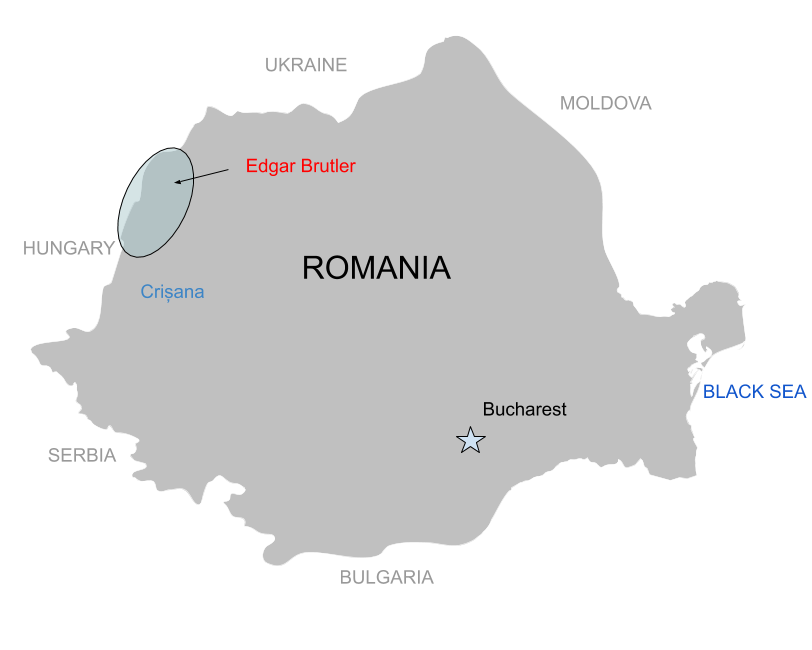
At a Glance
2018
https://www.brutler.com
Crișana, Transylvania
Continental
Clay, loam, sand
125m
Low hills
Fetească Regală, Fetească Albă, Welschriesling, Mustoasa de Măderat, Furmint, Blaufränkisch, Grünspitz
4 hectares
Organic
Natural
https://www.brutler.com
Crișana, Transylvania
Continental
Clay, loam, sand
125m
Low hills
Fetească Regală, Fetească Albă, Welschriesling, Mustoasa de Măderat, Furmint, Blaufränkisch, Grünspitz
4 hectares
Organic
Natural
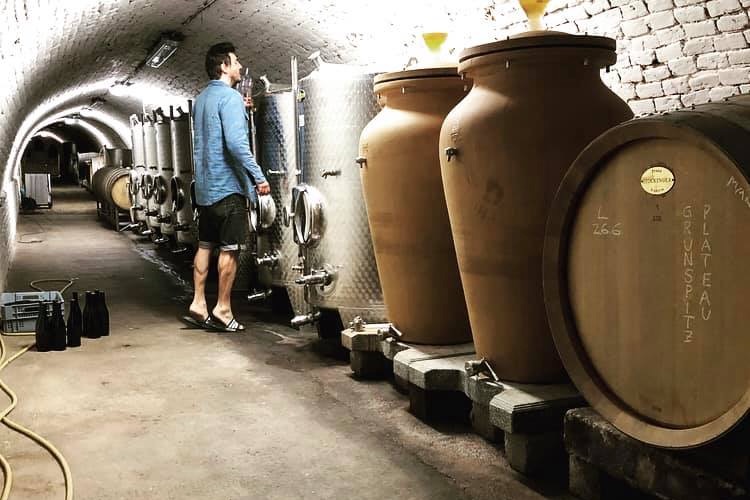
Edgar Brutler in the cellar - Credit Weingut Edgar Brutler
The Appellation
Transylvania has always been a bit of white whale for us. I don’t think you can get further away from what we think of as Europe while still being in Europe. This is where horse carts often outnumber cars, self sufficient agriculture is the norm, there are more fortified Churches than anywhere else in Europe, and where Vlad the Impaler once vertically impaled nearly 20,000 people on display near the city of Târgoviște to intimidate the Ottomans. Literally translating to "beyond the forest," it also has an unbroken winegrowing tradition going back at least 2000+ years. It’s also believed that Dionysus/Bacchus was born in Thrace in modern day Romania. It’s a surreal place where the language is Balkan Romance, the food is Hungarian with some key distinctions, and where the imprints of both the Middle Ages and Communism are frozen in time.
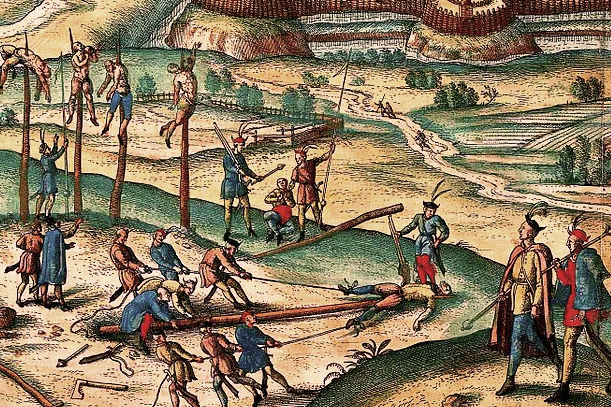
Vlad the Impaler
Skipping over vast swaths of history and using gross oversimplification in order to get to the wines at hand, a condensed historical refresher is still helpful. From 1003-1526, the Kingdom of Hungary ruled. Under King Stephen I in the 10th Century, Queen Gisela brought in Germans (Swabians) from her native Bavaria. It’s then a long tug of war between the Ottomans and Hapsburgs starting in the early 1500s until the Hapsburgs finally pushed out the Ottomans in 1691 during the Great Turkish War.
Romania’s official independence and its constitution didn't arrive until 1881. Through it all, Transylvania always fought to be a separate entity within the Hapsburg and Ottoman periods. WWI causes the collapse of the Austro-Hungarian Empire, Romania adds Transylvania and a few other regions back inside its borders. Things get messy in between WWI and WWII. Romania starts supplying a lot of oil to Hitler in exchange for being left alone. This doesn’t last long and meanwhile Hungary takes back Transylvania by force. Romania ends up switching sides and fighting with the Red Army to defeat German and Hungarian forces. Romania gets Transylvania back again. This was then followed by Soviet occupation and eventually becoming a Communist state in 1947. Romania does not enter this arrangement quietly and experiences some of the fiercest extrajudicial killings and purges of any Bloc country. And I don’t think this gets the attention it deserves, but Romania’s final autocrat Nicolae Ceaușescu and his wife Elena were captured after fleeing by helicopter and then killed by firing squad on Christmas Day 1989 following violent protests. This effectively ended the Communist era.
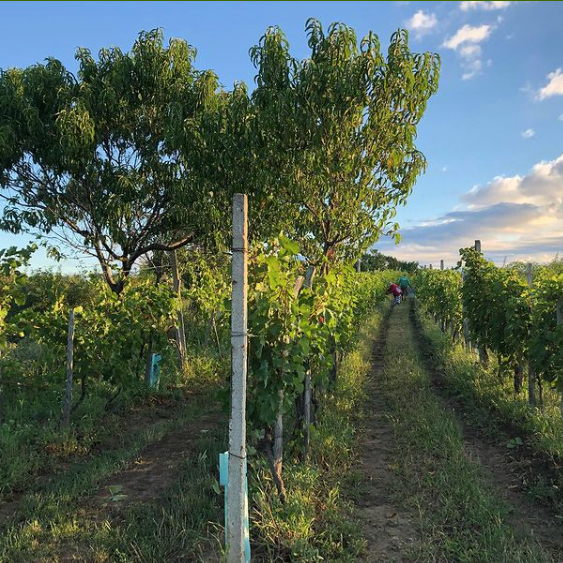
Edgar Brutler's vineyard during the harvest - Credit Weingut Edgar Brutler
During all of this, agriculture was at the heart of the Romanian character and economy. After WWI, it’s estimated that 90% of Romania’s agricultural land was owned in parcel’s no larger than 5 hectares – massive fragmentation. This was then collectivized by force during Communism. A lot of hybrids (Labrusca x Vinifera) were planted and the typical story of quantity over quality ensued. There were weird moments like PepsiCo importing Romanian wines in the 1970s under their Monsieur Henri Selection series (the wine was called Premiat) in exchange for cola concentrate. Suffice to say, this was not a good period. When Romania privatized land post Communism, it resulted in decades of legal battles, corruption, and confusion. This also led to little to no investment and for those willing to invest, often hundreds of land contracts were necessary to secure as little as 20 hectares. Today, the country is 5th under vine in Europe, but many estimate that the average vineyard holding is 0.2 hectares, and just over 30% of the country’s vineyards are farmed in 10 hectares or more. Romania is essentially a net importer.

The winery's seal - Credit Weingut Edgar Brutler
In a feeble attempt to change these export figures, we’d like to introduce our first Romanian producer: Weingut Edgar Brutler.

Vlad the Impaler
Skipping over vast swaths of history and using gross oversimplification in order to get to the wines at hand, a condensed historical refresher is still helpful. From 1003-1526, the Kingdom of Hungary ruled. Under King Stephen I in the 10th Century, Queen Gisela brought in Germans (Swabians) from her native Bavaria. It’s then a long tug of war between the Ottomans and Hapsburgs starting in the early 1500s until the Hapsburgs finally pushed out the Ottomans in 1691 during the Great Turkish War.
Romania’s official independence and its constitution didn't arrive until 1881. Through it all, Transylvania always fought to be a separate entity within the Hapsburg and Ottoman periods. WWI causes the collapse of the Austro-Hungarian Empire, Romania adds Transylvania and a few other regions back inside its borders. Things get messy in between WWI and WWII. Romania starts supplying a lot of oil to Hitler in exchange for being left alone. This doesn’t last long and meanwhile Hungary takes back Transylvania by force. Romania ends up switching sides and fighting with the Red Army to defeat German and Hungarian forces. Romania gets Transylvania back again. This was then followed by Soviet occupation and eventually becoming a Communist state in 1947. Romania does not enter this arrangement quietly and experiences some of the fiercest extrajudicial killings and purges of any Bloc country. And I don’t think this gets the attention it deserves, but Romania’s final autocrat Nicolae Ceaușescu and his wife Elena were captured after fleeing by helicopter and then killed by firing squad on Christmas Day 1989 following violent protests. This effectively ended the Communist era.

Edgar Brutler's vineyard during the harvest - Credit Weingut Edgar Brutler
During all of this, agriculture was at the heart of the Romanian character and economy. After WWI, it’s estimated that 90% of Romania’s agricultural land was owned in parcel’s no larger than 5 hectares – massive fragmentation. This was then collectivized by force during Communism. A lot of hybrids (Labrusca x Vinifera) were planted and the typical story of quantity over quality ensued. There were weird moments like PepsiCo importing Romanian wines in the 1970s under their Monsieur Henri Selection series (the wine was called Premiat) in exchange for cola concentrate. Suffice to say, this was not a good period. When Romania privatized land post Communism, it resulted in decades of legal battles, corruption, and confusion. This also led to little to no investment and for those willing to invest, often hundreds of land contracts were necessary to secure as little as 20 hectares. Today, the country is 5th under vine in Europe, but many estimate that the average vineyard holding is 0.2 hectares, and just over 30% of the country’s vineyards are farmed in 10 hectares or more. Romania is essentially a net importer.

The winery's seal - Credit Weingut Edgar Brutler
In a feeble attempt to change these export figures, we’d like to introduce our first Romanian producer: Weingut Edgar Brutler.
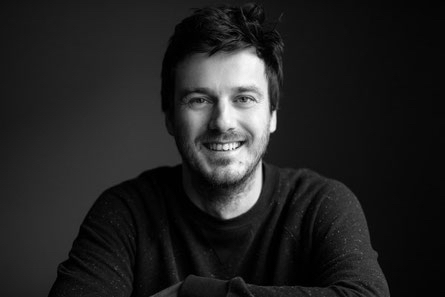
Edgar Brutler - Credit Weingut Edgar Brutler
The People
Edgar’s family was a part of the aforementioned Swabian migration to Transylvania and arrived in the 1850s from Stuttgart. They were not surprisingly farmers and according to Edgar’s grandfather, “a family with two or three kids needs 1000 liters of wine per year.” In the early 1980s the family left Romania because they could easily secure a German passport. Romania was in ruins due to Nicolae Ceaușescu’s austerity measures among other atrocities. In 1997 Edgar’s parents decided to move back after some land was restituted after the 1990 revolution. This was the beginning of a winery project that eventually grew to 25 hectares and the Brutler family was a 50/50 partner. Finally in 2008 the whole family moved back to Transylvania but decided to leave said project in 2018. There were zero regrets about their time as partners, but according to Edgar, “We were free then. Just a complete new start.” The shares from this sale are what have built the new winery although the vineyard land has always been with the family.
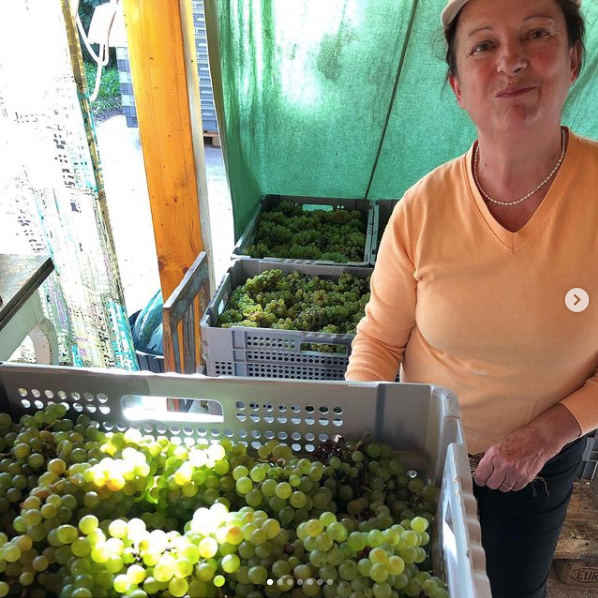
Edgar Brutler's mother eating Grünspitz - Credit Weingut Edgar Brutler
Edgar originally started down a musical path with violin at 6 followed by guitar at 16. The 6 hours of practicing a day in order to make this career wasn’t in the cards, but music still plays a big part in his life and an image of sound board levels adorn the label of the Grünspitz. He then studied oenology at Geisenheim because of the Romanian family vineyard. As Edgar puts it, “I was born there, my family lived there, my family worked these vineyards and walked this roads and paths.” He founded Weingut Edgar Brutler in 2018 with a focus on organic farming, native grapes, old vine field blends, and making wines based on smelling, tasting, and feeling rather than numbers and analytics.

The harvest team - Credit Weingut Edgar Brutler

Edgar Brutler's mother eating Grünspitz - Credit Weingut Edgar Brutler
Edgar originally started down a musical path with violin at 6 followed by guitar at 16. The 6 hours of practicing a day in order to make this career wasn’t in the cards, but music still plays a big part in his life and an image of sound board levels adorn the label of the Grünspitz. He then studied oenology at Geisenheim because of the Romanian family vineyard. As Edgar puts it, “I was born there, my family lived there, my family worked these vineyards and walked this roads and paths.” He founded Weingut Edgar Brutler in 2018 with a focus on organic farming, native grapes, old vine field blends, and making wines based on smelling, tasting, and feeling rather than numbers and analytics.

The harvest team - Credit Weingut Edgar Brutler
The Vineyards
The village of Beltiug is in Satu Mare County in the Crișana region. This northwestern corner of Romania has a temperate continental climate, not as much Adriatic influences as Miniș in the south, but surprisingly warm for what we think of as Northern Romania. The soil is really thick loam (20-30 meters) and plantings date back as far as 1926 and as recent as last year. Edgar’s grandfather planted their original 4 hectares. The traditional grapes of the area are Fetească Regală/Königliche Mädchentraube, Fetească Albă, Welschriesling, Mustoasa de Măderat, Furmint, Kékfrankos/Blaufränkisch, and their signature grape of Grünspitz. He has new plantings of Baras and Juhfark in the works. There are a number of unidentifiable grapes in the older field blends as well. Farming is without herbicides, chemical-synthetic sprays and mineral fertilizers. Spacing is 1 meter so everything is labor intensive and must be done by hand.

In the cellar - Credit Weingut Edgar Brutler

In the cellar - Credit Weingut Edgar Brutler
Winemaking
Given his formal education at Geisenheim and working at larger more technical wineries, Edgar has a firm grasp of the science and the predetermined recipes needed for those kinds of wines. It’s also incredibly useful information when stripping everything away and has allowed him to open up his mind, take risks, and activate the same part of his brain that brings him joy from music. Except for his pét-nat where he measures density to ensure bottles aren’t exploding, he’s not picking, pressing or doing anything based on the numbers.

Fiend blend press cake - Credit Weingut Edgar Brutler
All wines are spontaneously fermented in a 200 year old cellar, unfiltered, and the only addition is SO2 (10-20ppm) at bottling and many are without any additions at all. He’s also adamant about the control and feedback from using a basket press. Especially for the Grünspitz where a long and high pressure pressing is essential in managing the tannins and extraction. There’s no cell phone reception or internet in the cellar. Deep and quiet.

Skin maceration - Credit Weingut Edgar Brutler

Fiend blend press cake - Credit Weingut Edgar Brutler
All wines are spontaneously fermented in a 200 year old cellar, unfiltered, and the only addition is SO2 (10-20ppm) at bottling and many are without any additions at all. He’s also adamant about the control and feedback from using a basket press. Especially for the Grünspitz where a long and high pressure pressing is essential in managing the tannins and extraction. There’s no cell phone reception or internet in the cellar. Deep and quiet.

Skin maceration - Credit Weingut Edgar Brutler

White Wine , Organic
Fetească Regală;
10.7%
1.4 g/l
5.77 g/l
Fetească Regală;
10.7%
1.4 g/l
5.77 g/l
Drum Bun translates to “bon voyage” and can be seen on every sign as you travel from village to village. Should you be seeing these sings, ideally you’re driving a Dacia 1300. This glorious automobile is the standard-bearer of the Romanian fleet and is as famous as the ubiquitous Fetească Regală grape. 50% spends 2 days on the skins and 20% direct pressed in barrel and the rest is fermented in tank with zero maceration. Edgar has learned to never rack too close to bottling and give it both time to come around. This patience pays off and we get a rare glimpse into what this grape is capable of outside of the more reductive, lower acid, halted malo, super aromatic and industrial versions that otherwise dominate the market.

Red Wine , Organic
various;
10.5%
1.52 g/l
5.7 g/l
various;
10.5%
1.52 g/l
5.7 g/l
This might be the longest write up for a wine we will only have a few cases of, but it anecdotally sums so much up about this family. In short, this wine is dedicated to a chicken. The Brutler family keeps many chickens, but this one was routinely attacked by the others. Perhaps they were jealous of her sweet character. In any case Edgar’s mother took the chicken into the home with the dogs and she became a fixture next to his father in the garden and on a chair at the dining table. Sadly, she likely ate from the dog bowl, got sick and died prematurely. According to Edgar, “my Dad gets tears in his eyes when we speak about her.” On the wine front, all of the fruit comes from a site planted in the 1970s by his father’s family that was near death not too long ago. In 2019 they only got enough fruit for one 225L barrel. After years of compost, precise pruning and handwork, it’s now back to full strength and we are lucky enough to get some. The co-fermented field blend is mostly comprised of Fetească Regală, Grüner Veltliner, Italian Riesling, a few Muskatel, a block of Mustoasă de Măderat and some red grapes like Portugieser, Kadarka, and Blaufränkisch. Very similar to the Wieso?Nicht! in terms of red and white grapes, but where the latter goes ultimately in a red wine direction, the Gisela is more of a Rosé. Everything was crushed with stems, pressed, and then fermented and aged in one 500L and another 300L oak barrel.

White Wine , Organic
Grünspitz;
11.2%
1.8 g/l
6.3 g/l
Grünspitz;
11.2%
1.8 g/l
6.3 g/l
Their 15 year-old .8 hectare vineyard is one of only two known vineyards of Grünspitz in the world. It was traditionally grown in the field blends of the area, but it was grandfather Schmied that decided to keep a small vineyard alive through quite some history in Romania. Johann Brutler (Edgar’s father) took cuttings from here and planted them in Beltiug. The grape is super late ripening, small berried, thick skinned, and sings with acidity. It needs a long pressing with high pressure to manage the tannins and extra time in the bottle to come together. Grünspitz is a workhorse grape in that it can easily make pét-nat, rich macerated wines, super fresh whole cluster, and in this case, a really elegant, crispy and goldilocks between these extremes. The 2022 was whole bunch pressed and aged 90% in oak barrels and 10% in amphora.

White Wine , Organic
various;
11.4%
0.94 g/l
6.6 g/l
various;
11.4%
0.94 g/l
6.6 g/l
This is a field blend from two different sites fermented separately and then blended. Edgar estimates at least 15 different grapes including many that are still unidentified even after DNA analysis, but the biggest players are Fetească Regală and Olaszrizling. Both vineyards are hand picked and spend two days on the skins but one with stems and the other without. Fermented and aged in both amphora, concrete egg and oak, it needs a few minutes to wake up, but occupies that wonderful juicy place with just a subtle touch from the light maceration. The name of the wine is a nod to a "Sajtóház", or press house in the vineyard where his grandparents would both make wine and occasionally sleep. As Edgar puts it, “this wine is pure juice.” Bottled unfiltered with 10ppm SO2.

Red Wine , Organic
Syrah; Cabernet Franc;
13%
0.33 g/l
6.01 g/l
Syrah; Cabernet Franc;
13%
0.33 g/l
6.01 g/l
This Sefu Red is a blend of Syrah and Cabernet Franc. The Cabernet Franc is direct pressed and fermented in one 3000L stainless steel tank and six 500L oak barrels. The Syrah is whole bunch pressed into open vats, macerated for three days, and right as fermentation starts to kick off, it’s pressed and fermented in four 500L oak barrels and three 225L oak barrels. Bottled unfined and unfiltered with the only addition being 15ppm of total SO2.

White Wine , Organic
Chardonnay; Riesling; Furmint; Tămâioasă Românească;
11.8%
1.33 g/l
6.53 g/l
Chardonnay; Riesling; Furmint; Tămâioasă Românească;
11.8%
1.33 g/l
6.53 g/l
The Sefu White is picked from left to right regardless of grape. Nothing is blended, it’s a full co-fermented field blend of Chardonnay, Riesling, Furmint, and Tămâioasă Românească. For this vintage, the grapes were pressed at Laci’s cellar and Edgar picked up the fresh juice to be settled out in tank back at his cellar for 24 hours. The pressing is hard to avoid solids, bad tannins, and reduction. It’s then fermented in three 225L oak barrels, one 3000L stainless steel tank, and three 1000L stainless steel tanks. In total, it’s about 80% stainless to 20% barrel. Bottled unfined and unfiltered with the only addition being a total SO2 of 20ppm.

Sparkling Wine , Organic
Grünspitz;
8.8%
1.28 g/l
10.65 g/l
Grünspitz;
8.8%
1.28 g/l
10.65 g/l
This vintage went dry super fast and needed some fresh 2023 fruit to get back up the residual sugar this wine absolutely requires. The previous vintage was technically a “demi sec” despite many, including ourselves, perceiving it as Brut if not Brut Natur. To imagine drinking it fully dry would be an act of self-flagellation. In any case, this is a Pét-nat made from 100% Grünspitz. Sisu is a Finnish word that roughly translates to a strong willpower to go through difficult times even if it seems hopeless. Apart from being wildly appropriate for this vintage and the wine business as a whole, it’s also the required mindset to tackle the thick skins of the grape and retain freshness. Foot trodden in the press is where the tannins come from. There’s no extended maceration here. This is then followed by a super slow fermentation in tank and finished with around 10 g/l RS to balance out the acidity and texture. It was disgorged once in February to blow out the tartaric acid, but keep most of the sediment. Super limited, but a completely unique pét-nat.

White Wine , Organic
Grünspitz;
11.8%
0.84 g/l
6.16 g/l
Grünspitz;
11.8%
0.84 g/l
6.16 g/l
Grünspitz is what led us to Edgar in the first place. This bottling is a particularly intense middle part of the steep vineyard where rain has washed away the loam leaving mostly gravel. Ripeness is a moving target here and normally takes 6 separate harvests passes due to the grade. The lower part of the vineyard is often up to 4 weeks behind. This 2021 represents the ripeness from the added heat retained in the soil and exposure. Fermented in 600 L barrel and Amphora, it’s simply called “Spitz” and drops the “Grün.” According to Edgar, “it is far away from being green.”

White Wine , Organic
various;
10.8%
0.9 g/l
7.35 g/l
various;
10.8%
0.9 g/l
7.35 g/l
If you can’t find a solid village wine, then it’s probably best to move on to the next village. Vinul Casei alb (white house wine) gives you every reason to stay and dig into this place. This is from a small field blend planted in 1926 consisting mostly of Grünspitz, Fetească Regală, and Welschriesling. They also buy a small amount from their friend Laci who organically farms some Rhine Riesling, Furmint and Chardonnay. The 2022 was 80% tank fermented and 20% in 600L oak barrels. A liter is the smallest possible vessel for this kind of wine. The village of Beltiug has over 300 private cellars and Edgar loves to stroll around, talk to people, and is inevitably offered some wine. There’s something aromatic and distinct that’s shared in all of these wines. As Edgar puts it, “while drinking it I want you to imagine how you are standing in a small private cellar while the winemaker tells you about his worries and joys. A moment when you can forget everything else – these are some of the favorite hours of my life. The label might seem very basic. Basic like the wines you could find and drink in Beltiug. But the emotional complexity of these wines is deeper and more extensive than you can imagine.”

Red Wine , Organic
various;
10.5%
1.62 g/l
6.22 g/l
various;
10.5%
1.62 g/l
6.22 g/l
This is a field blend from a 40+ year-old site consisting mostly of Blaufränkisch, Portugieser, Welschriesling, Fetească Regală, and a little floater of Merlot and a few yet to be identified grapes. Everything was destemmed and then co-fermented in open vats for two days. Pressed and aged in 500L and 225L oak barrels, it was bottled unfiltered with around 10 ppm of SO2. While it’s certainly in the chilled red/Siller category, it has enough grip and ripeness to satisfy a red wine drinker with the acidity and aromatics to please a white wine drinker as well. Wieso?Nicht! (Why?Not!) just combine all this old vine goodness together like Edgar’s grandfather did in the first place.